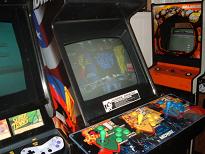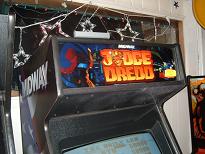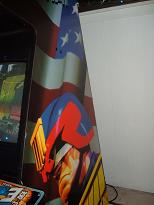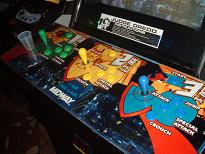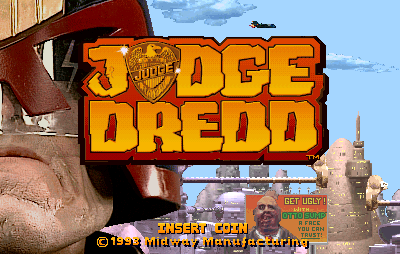
EDITOR'S NOTE:
We appear to have had an influx of visitors from MAMEWorld.info as this not-really-an-interview thing got linked on their front page
So, hello, MAMErs! We'd just like to remind you that there's more to our site than just this page. Read the rest of it, punks!
As you should know, we were lucky enough to get insight into Judge Dredd's development from two people who worked on the game, Jake Simpson (Programmer) and Eric Kinkead (Artist). We interspersed their comments throughout our playthrough of Judge Dredd, but there may be some of those among you who'd rather just read what they have to say straight-up. Besides, we didn't quite get all of their comments into our playthrough.
So, here's the rise and fall of Judge Dredd Arcade, told by some of the people who made it.
Origin of the Game
Jake Simpson:
So, I'm Jake Simpson, one of the two programmers on it. Mark Penacho was the other. I'm actually British (through and through), so I knew Judge Dredd really well - I came to Midway / Williams in 1992, literally having just got married before starting. The reason Judge Dredd came about was primarily because Midway was having such great success with Terminator 2, they were looking for other movie licensed IP to work with. The Judge Dredd movie had just been announced and so that's why they picked it up. All 4 of us on the team were massive fans, so we wanted to do it.
So, the actual premise of the game was it was supposed to be a cross between MK and Teenage Mutant Ninja Turtles - we literally had one in my office to play, the 4 player version, just like Ed Boon had a Street Fighter 2 in his office while he was making Mortal Kombat. There was some influence from Bionic Commando as well, as I recall. We wanted each level to have a different mechanic (although not too different) because at the time, no one else had done that, at least not in a brawler
Eric Kinkead:
I was hired into Midway a few months after Jake. I remember John Vogel and Tim Colman taking particular interest in a rendering in my sketchbook of Judge Anderson of the PSI division. John and Tim where also huge fans of Judge Dredd as most hardcore comic collectors and artists where at the time. However, Judge Dredd was very, very underground in the States at the time. In America you to be exposed to Judge Dredd you had to be
a) from England with a love for English Sci-Fi. (Jake Simpson*)
b) a comic book nerd ball (Tim and John)
c) into heavy metal + art + the crossover of GamesWorkshop and the current English grindcore/thrash movement.
I was the 'C' factor to the tee. I was making a lot of digitized art of steel girders around the industrial sites of Chicago. I was also making 3D art in the back room on the only AMIGA the company had. Tim and John took interest in this since they had the head of Judge Dredd for the side cabinet outsourced into a beautiful 3D rendering. (not the judge dread face on the intro screen, that was prosthetics we had made for Sal). That with my unbridled enthusiasm I was a perfect candidate for the team I suppose.
Development Facts
The Cabinet
Jake Simpson:
The control panel did indeed come from NARC. I hated it, but everyone else said it had worked out well with NARC. This was my first game, so I just let it go. [Regarding the cabinet art] We pioneered the multi-color cabinet printing too - till then all cabinets where 4 color process - we started the mixing of colors. The cabinet was the standard Midway universal cabinet - about the only thing unique about it was the red piping down the side.
Eric Kinkead adds:
And the side of the cabinet had the 3D Judge head that Tim had contracted out in 3D. Looked beautiful. After Killer Instinct from Rare made it to the Midway offices it was bitter sweet yet again that Judge Dredd was the first to have 3D art on the side of the cabinet art.
[Here are some photos of a Judge Dredd cabinet, taken by Schusler of arcade-museum.com.]
[This machine was seen at the Star Worlds Arcade in DeKalb, Illinois.]
[Click to embiggen:]
The Graphics
Jake Simpson:
The digitized approach was there simply because we had the tech to do it and we'd had such success with Terminator 2, MK and NBA JAM. It was a Midway signature, so to speak. The images were heavily colorized though. We actually pioneered the new way of capturing video in real time that MK II used to create such clearer imagery than MK I had - MK I used a video camera and taped all the action, then it was captured later. We actually captured directly on the bluescreen stage directly and got MUCH better results. MK II used the same approach.
We did spend some time wondering if we should try and be visually what the movie was, but it was so far out at that time that we gave up waiting, and just got on with it.
We spent a LOT of time trying to ensure that we were faithful to the comics and that the story made sense (all the cloning booths). Too much time really. The guys in the UK who owned 2000AD were seriously cool though - they just approved everything with almost never any comment - just let us do our thing.
The Precious Leglock and Judge Death mannequins where made by the game guy who made the Goro models for MK. The Judge Death one was pretty damn awesome. I wish I knew where they ended up - John Vogel probably still has them.
Eric Kinkead:
Oh man, that Judge Death model was so awesome. At least, if not as cool as Goro. I would go into either Tim or John's office and look at that thing constantly. Although that close up picture of him doesn't make me feel so bad about some of my jaggy pixelated art in the game. Doesn't do the model justice.
I want to throw in my 15 seconds of fame. Judge Dredd had the first in game sprites of any Midway game to use 3D graphics. I used the AMIGA in the back room to make the animations for the Willis Power Tower. Realizing that the AMIGA was on the way out, I wanted new software since I had been making 3D graphics and requested the order of Autodesk 3D studio. We found a local dealer of that powerful art software, I organized a demo, got approval and Midway was officially in the business of officially using third party 3D software for the rest of their games.
Judge Dredd factoid: The rat [from the sewers in Wave 1].
You just couldn't grab some public domain digital image of a rat off the internet in 1992. All images worth scanning are in print, so we couldn't flat scan anything due to fear of copyright infringement laws. So we got a Rat. They got the rat from a pet store, he was to be snake food. RATTO. John and Tim filmed it. Then we had a rat. In the office.
I ended up adopting it and keeping it in a cage at my apartment. A person from the the island of Kings, Queens and Dragons would call an apartment a 'flat'. It mysteriously 'ran away' into a back alley behind this 'flat' with dumpsters and other city rats.
The Stages
Jake Simpson:
The jumping level with the robots literally went in about a month before test. It was only because Eric had done some renders of robots and we looked at it them and went "What can we do with this?" - Eric and I built that alone very quickly. I'm just amazed we got it in at all - the codebase was not happy about having that injected into it. I'd never even attempted to code a platformer before and had no real idea what I was doing.
Eric Kinkead adds:
Yeah, the Robots are totally out of place. Way too large. Not my most fondest pieces of work. But no one expected the game to abruptly be cancelled.
Jake Simpson:
The Block Wars thing was really hard to balance - I never really got it right nor did I get the multi-angle attacks working as correctly as we'd envisioned - if you had too many people they'd bunch up and bounce off each other, but not enough and there was no challenge.
Yes, some of the levels were too hard. They were absolutely designed to be quarter suckers. The trouble with games like this - story games - is that most of the time people will only play through once. This isn't a sports or combat game where you play to test your skills against another player, so you replay. This is a once through kind of game, so we needed to take as many quarters as we could without pissing off the player, so things were definitely harder than they should be for playing for free on MAME.
We totally underestimated the amount of work it was to do it properly and then tweak it - the problem with Judge Dredd was that we didn't have a "tweaker" - both Mark and I were what you'd call today Technology Programmers. Neither of us were game tweakers, like Mark Turmell or Ed Boon - they have that extremely rare talent of being able to take what's there and tweak the numbers till it was fun. Lacking that, we never got that right combination of physics and fun.
Technical Aspects
Jake Simpson:
We ran out of video memory really early on - our animations were so much nicer originally but we ran out of space really fast. I remember sitting there for days, cutting up images so we were only storing actual images and not the space around them. We also ran into rendering limitations. Originally the city was way more populated than it ended up being - lots more clouds, little ships in the sky, pedestrians and so on. But we kept running into 'bog' situations, where we were trying to render more than could be pushed into 1/60th of a second. Back then we were almost never CPU bound, it was always blit bound.
The operating system we sat on was the same as all the Midway games at that time used. It was pure ASM (all the games up till Blitz were) on an Motorola 34010 chip (no floating point!) and I think we had about 16megs of image space? Something like that. The operating system was actually a re-write of the same operating system that Eugene Jarvis had written for Robotron, just for the new processor. All games used it so programmers could go from one game to another relatively easily and just be productive very quickly. The development environment (well, debugger really) was home grown and actually pretty powerful, once you figured out how to use it.
Eric Kinkead adds:
Speaking of floating point. The first mass order of Autodesk Studio release 1.2 I ordered for a whopping $3,000 each required floating point processors on the computers. We only had a handful of 486 DX computers for the programmers and a ton of 386 computers with no math co-processor for the artists. This caused a mad rush to upgrade everyone with Math Coprocessor chips and was the first wave of what would be a Tsunami of upgrades into 3D.
The Staff
Eric Kinkead:
Jake and I had a great friendly antagonistic relationship which I think started with my fascination of all things from Great Britain at the time. I would walk into his office ask him to talk to me, he soon figured out it was so I could listen to his dialect. (I was from Texas and 20 years old. Never did seen one of 'dem British fellows up close) That would be followed with a "get the hell out of my office" and I would think up as many B words as possible to yell while leaving… "Bugger... Bullocks... Blimey... Blokes..." (Some of those are Aussie? I think that made it worse).
Something to note about people's involvement. You have to realize how small everything was. When Revolution X was nearing completion, there was talk about the game not being able to be completed because the team was so HUGE and unwieldy. There was a whopping total of around 12-14 people on it, many from different games. Our games only had handfuls of people working on hands on assets back then.
The entire department, from Sheridin in the back who did physical engineering soldering, etc. to Jake programming, to Sal Davita- the whole operation of the entire video game department had to be under 35 people. EVERYONE played all the games, tested all the games and gave valuable input into the games. I must have spent hours and hours play testing Mortal Kombat II for Ed Boon in his office and frustrating him with cheap tap moves (Maybe too much time.) All of us contributed to each other's projects.
So what Mark Turmell did by including the entire department in NBA Jam Tournament edition was really the pinnacle of the Williams/Bally/Midway spirit. THAT was the point of Camelot for Midway. The round table and white castle on the hill.
Unused Content
Jake Simpson:
[In Wave 1] you could smash up most of the store fronts in the original implementation. It had to go because of memory constraints.
The last level was basically Judge Death in Resyk - he was reanimating corpses that were rolling out on a conveyor belt at the back of the screen and you were shooting them and him - you'd have your gun but it could be knocked out of your hand and you'd be manno e-manno until another one dropped into the level. We actually had most of it running - Mark was working on that level.
There was another level we had which got cut - the motorcycle chase. It was a top down thing, where you were on his bike and you had to chase a car on a high ramp over the city. The ramp was damaged so you had to jump sections. It was originally designed to be like Spy Hunter. We cut it because honestly, it was no challenge. A few jumps, some left and right and that was it. Looked gorgeous though, but all that really nice Mega City At Night imagery took up way too much image space, so we cut it entirely. The idea was to have a shooting gallery, then a real game level, then the bike chase, then a real game level, then the shooting gallery etc.
Eric Kinkead adds:
This is a real shame it was cut out. It was hands down the best looking thing I can remember. I think it was one of the first things I had seen.
Jake Simpson:
The version in Mame is almost what we had completed, but not quite. The code for the Motorcycle was there, but none of the graphics were. Graphics space was very tight and so when we removed the motorcycle wave, the graphics came out to make room for other stuff. The Judge Death stuff was about 60-70% done. We had Judge Death leaping around and attacking you, that much I do remember. I don't remember if he was reanimating corpses though, even though I knew that was the plan.
I honestly do NOT remember the Boss Rush wave. I think that was something Mark put in, just re-using the same AI code for each of the bosses. I would imagine it would have come either pre or post Judge Death. I really have no memory of it.
The way it was coded, all the AI was actually in the animation scripts for each of the characters. It would run through a set of animations and at key points, call functions to determine what to do next- so with fink he'd frame to frame doing his idle script, then on the last frame, he'd run a function that would determine if he'd move towards you, move away from you or just keep doing his idle.
The point of explaining this that this results in a bad guy you can drop in anywhere, in any level, with any other badguy and it all still works. Precious, Judge Death, The Angels, they were all coded the same way. I think the Fink had some extra code because it took into consideration other potential NPC's in the scene whereas the boss monsters did not. So the practical upshot of which is that to create a level like this is really easy. Just create one boss monster after the other and it's done. I think that's why this exists - just because it was quick and easy to do.
The Game's Location Test + Cancellation
Jake Simpson
Only 4 machines were made. I had one, that went to my sisters pub in the UK and was destroyed when that burnt down. One went to Tim Coman, one went to Mark Penacho and I've no idea where the last one ended up. I also have no idea how the ROMs got out into the world - I will say that they weren't the final ones we put out in the world though. I remember the 3:10 time thing not being right and fixing that, and also fixing the problems with the missiles coming at you on the shooting gallery (basically only holo targets on the opposite side of the screen would fire at you).
I honestly don't remember when we were testing. It would have been late 92 / early 93 though. We tested purely in Chicago for Judge Dredd - we were still relatively early in development to be testing - normally the game doesn't go out on test till it's 100% complete and we weren't - but we were starting to get glimmers of the fact that this wasn't going to be great and we wanted to know early so we could just put a bullet in it and stop wasting our time, if that was the case, as it turned out to be.
We never finished it because we put it out on test and it just didn't do great numbers. The only reason we had 3 players was because we couldn't fit 4 on the control panel. NBA JAM uses a wide panel to fit them all on, and we were trying to keep costs down. I remember having a bug that crashed the game in the block wars and that totally destroyed our on test numbers. I remember at the time NBA JAM was out, MK was out, and our numbers were no where near theirs, so we all got very demoralized and just gave up. In retrospect we _should_ have finished this - Midway paid for the license and we should have completed it. We probably could have in a month. I remember the meeting where we all sat there and looked at each other and just shrugged and said "What were we thinking?". We were young and stupid. Enough said.
I think part of the reason we did abandon it was because it *was* such a labor of love, and it just wasn't living up to our expectations, either in what the game was or how it was doing on test.
Additionally, Jake Simpson gave us some documents written after game's location test:
DREDFAIL, the location test report, listing what worked with the game, what didn't, and suggestions for improvement.
DREDAGIN, a proposal written four months after giving up on the game to try and salvage it.
DREDDM, another proposal to fix the game, this time as a lightgun shooter based closely on the movie (and Steel Gunners)
And so ends the story of Judge Dredd Arcade.
Remember, punk- Judge Dredd is the law, and you'd better believe it!
Thanks go out to Jake Simpson and Eric Kinkead for emailing us. Go back to the index!

